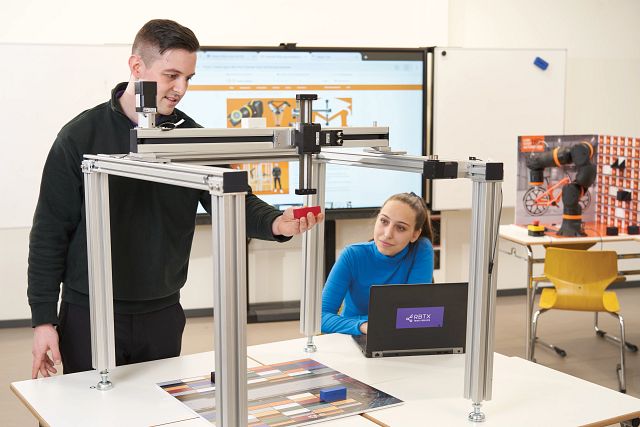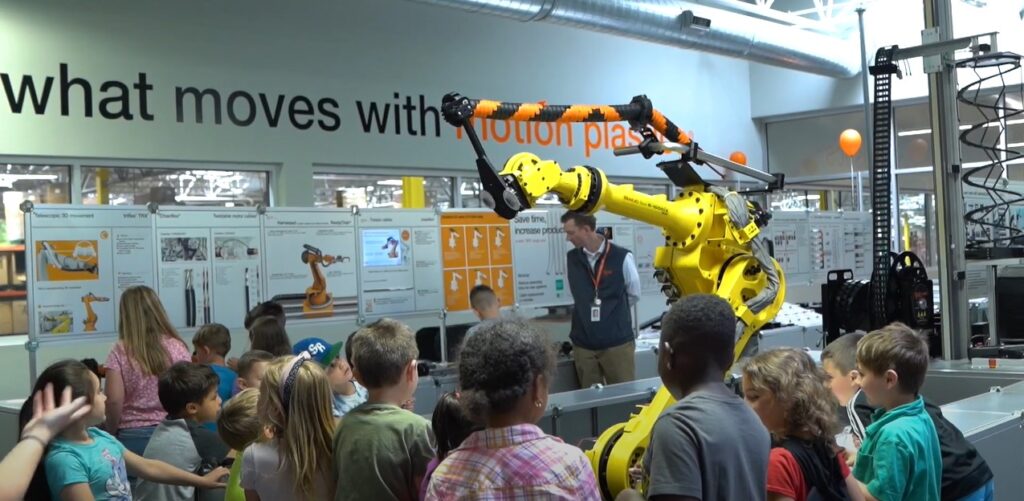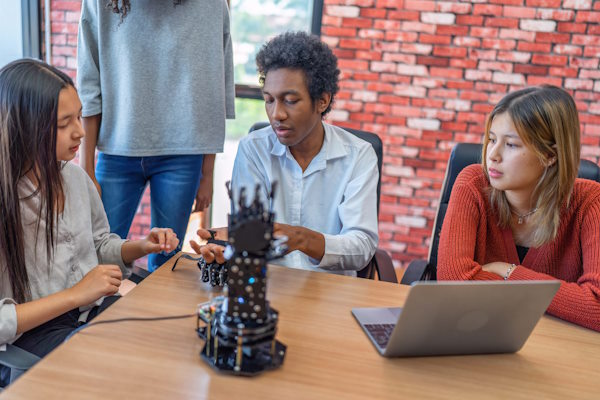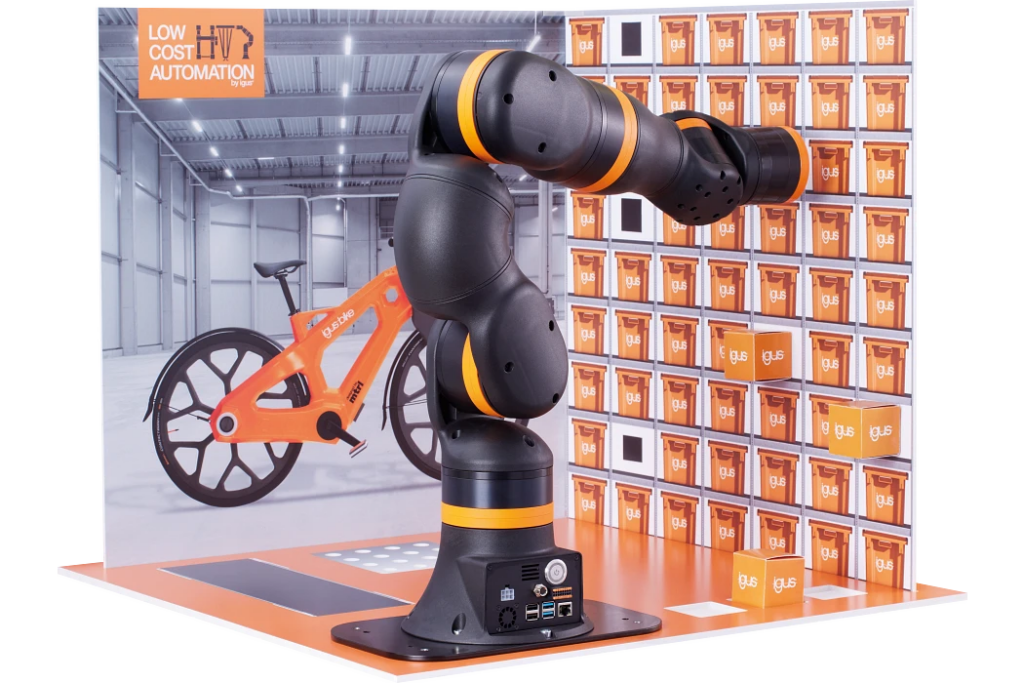Educational robots: Enriching students’ education
New technological advancements and achievements are impacting nearly every aspect of daily life across the globe. One such groundbreaking advancement is the integration of robotics into education, primarily high school and college-level education. Robots, once reserved for industrial applications and cutting-edge research, have found their way into the hands of students thanks to affordable automation products becoming more widespread. This has created an interactive and engaging learning experience that goes beyond textbooks. This blog explores the various benefits of incorporating educational robots at each level of education and some of the options available to do so.

Interactive Learning Experience
Educational robots bring theoretical concepts to life, making learning more tangible and practical for students. In high schools and colleges, hands-on activities using robots allow students to experiment with real-world scenarios, fostering a deeper understanding of complex subjects such as physics, mathematics, and programming. Through the creation and manipulation of robots, students can bridge the gap between theory and application, promoting a more profound comprehension of academic concepts.
Hands-on experience with robots also gives students a decisive edge when entering the workforce. The knowledge gained from working with and programming robots gives them the practical experience and knowledge required by even entry-level positions in the robotics industry.
STEM Skill Development
The integration of robotics in education aligns seamlessly with the emphasis many institutions are placing on Science, Technology, Engineering, and Mathematics (STEM) education. Robotics projects require students to apply critical thinking, problem-solving, and creativity — essential skills for success in the 21st century. Exposure to educational robots at an early stage prepares students for future careers in STEM fields, addressing the growing demand for a skilled workforce in technology-driven industries.
Robotics in Primary Education
The use of robotics in education isn’t strictly limited to high schools and colleges. Students in primary education can benefit even more significantly than students in secondary education or beyond, as children can learn new skills more quickly and efficiently than older students and adults. It is therefore ideal to implement robotics into education as early as possible to help maximize the benefit for students and give them the greatest opportunity to pursue a passion in robotics.

Preparation for Industry 4.0
As many industries transition into the era of Industry 4.0, where automation and smart technologies dominate, it is crucial for students to be well-versed in the principles of robotics. High school and college-level robotics programs not only expose students to current technology but also prepare them for a future where robotics and automation will be integral components of various industries. This forward-looking approach ensures that students are equipped with the skills needed to thrive in the evolving job market.
Team Collaboration and Communication
Robotics projects often involve teamwork, requiring students to collaborate, communicate, and delegate tasks effectively. These collaborative experiences mirror real-world work environments and help students develop interpersonal skills that are invaluable in both academic and professional settings. Working on a robotics project encourages students to share ideas, resolve conflicts, and collectively achieve a common goal. These skills extend beyond the realm of robotics into all aspects of life.
Inclusivity and Diversity
Robotics provides an inclusive learning environment, appealing to students with varied interests and abilities. Students who may not be traditionally drawn to STEM subjects find robotics engaging and accessible. This inclusivity contributes to a more diverse representation in STEM fields, breaking down barriers and encouraging students from all backgrounds to explore and pursue careers in technology.
Blending Robotics and AI
AI and robotics can be blended together in real-world applications, and the same can (and should) be done in education as well.

AI and robotics are a logical pairing, with AI enabling features like complex vision systems, independent decision making, and natural language processing possible. This will allow robots to complete a much greater variety of tasks, but the true potential of these tasks can only be achieved with proper education of the topic.
AI and robotics education can be combined in schools and universities to create a more cohesive and well-rounded program. At the same time, the ethics of AI can be discussed and taught to students to ensure proper use of the powerful technology.
Related: The University Student’s Guide to Ethical AI Use
Educational Robot Products
igus’® focus on developing low-cost automation products and solutions has led to the creation of a product line that lends itself perfectly to educational robotics. Gantries, delta robots, robotic arms and cobots are all offered at competitive prices, and each can be easily controlled and programmed with the igus Robot Control (iRC) software. This free software is aimed at making the programming of all types of robots as accessible as possible.
igus also offers education kits for both delta robots and the ReBeL cobot. These kits are aimed at colleges and universities, and each offers over 100 hours of learning material focused on developing programming knowledge through realistic scenarios involving common applications.

Finally, the Young Engineers Support (YES) Program developed by igus provides high school and college students access to free and discounted product samples, catalogs, workshops, and more. The program supports various academic disciplines — primarily robotics — across the globe. To this end, robotics competitions like BEST® Robotics and Botball® are provided with part kits from igus as part of the YES Program.
Conclusion
Incorporating educational robots into high school and college-level education is a major step towards preparing students for the challenges and opportunities of the future. By offering hands-on experiences, fostering STEM skills, and promoting collaboration, robotics programs contribute to a well-rounded education that goes beyond textbooks and lectures. As we continue to embrace technological advancements, the integration of robotics in education stands as a testament to the transformative power of innovative teaching methods, shaping the next generation of thinkers, creators, and problem-solvers.



